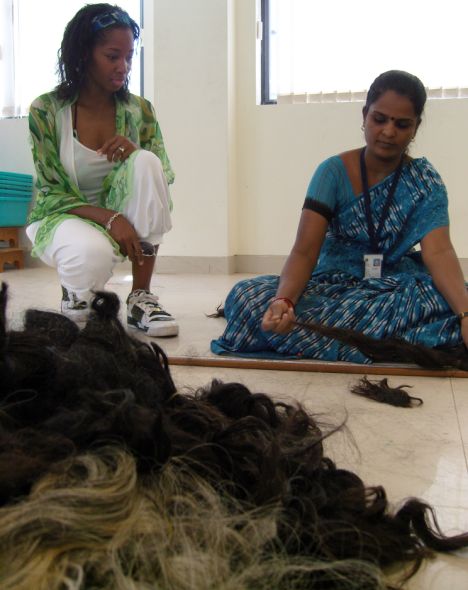
NOTE: Radiant Roots no longer creates synthetic hair permanent dreadlock extensions, but this information remains on this site for educational purposes!
In regards to human hair, the fact is simple that it is human hair! Not only does human hair lock and behave just like your own natural hair, but the texture also feels and appears most similar. It can be dyed and styled like any other natural, human hair. However, there are two main downsides to human hair: the cost and the ethics of the human hair extension industry.
As far as price is concerned, a single weft of human hair typically ranges anywhere between $50 and $250, or even more depending on the quality of the hair. Typically, there are two different kinds of human hair that can be purchase; Non-Remy and Remy. Non-Remy hair is also called “fallen hair” and is not arranged all in the same direction. Because of this, non-remy hair is also prone to tangling and matting. It also means that when the hair is processed by the companies that package and sell it that it is often processed more so than higher quality hair. Therefore, it ends up more damaged and is usually a much poorer quality by the time it reaches the consumer in a store. The most common way that this kind of hair is obtained is by foragers (usually a family business) who literally sift through trash (this is especially prevalent in Asia; Russia, China, and India) for matted hair from hair brushes or combs that has been discarded. Rest assured, that this hair, like all human hair that is sold, is cleaned, sterilized, and process prior to being sold in stores.

Remy hair is hair that is cut and arranged so that all the cuticles are going in the same direction from strand to strand. When this is the case, the hair is processed less and is in a much better quality when it reaches the consumer. Human hair is also ocassionally sold in bulk, especially kinky human hair. This hair is most frequently collected from temples in India where the process of cutting the hair is considered one of the deepest religious sacrifices: the shaving often represents a last-ditch plea to a higher power or by poverty-stricken individuals who sell their hair because they have no other choice to be able to afford to eat. However, most of the individuals who sacrifice their hair in temples do not realize that their hair, although casually tossed into a bin afterwards, will be sold, processed, and re-sold at great profit to Westerners who crave the appearance of long, luscious locks. Those who knowingly sell their hair are lucky to receive a fifth of what it will cost someone in a salon to have that hair sewn into their hair. In many of these cultures, too, long hair is considered a status symbol. In India, for example, the length of a woman’s hair is, culturally, directly tied to her prospects for marriage. Some claim that hair is even collected from dead bodies as well. However, this is a wildly debated claim.
The other option is synthetic hair. Synthetic hair has a noticeably different texture and feel than human hair. However, in some ways, the fact that it is plastic can work in favor of the process, too. The process of dreading synthetic hair is approximately the same as human hair, typically, but there is a choice over what is done from that point. Many who prefer a more natural appearance with synthetic hair will simply backcomb (or rip and twist) and then crochet and leave them as is. The other option, is that some will, again, either backcomb or rip and twist the synthetic hair and then “seal” it. Since synthetic hair is plastic, applying controlled heat will “set” the hair into the desired shape. However, traditionally hair styling tools (straighteners, curling irons, etc.) can MELT the hair, so care must be taken.
The upside to synthetic extensions is that they are considerable cheaper than human hair. Four to six “jumbo braids” (how synthetic hair is often sold, and the approximate amount needed for an entire head) cost approximately $20, as opposed to several times that for human hair. For many this extreme difference in price is a major determining factor. However, as far as ethics are concerned, the environment must be considered. Just like all plastics, synthetic hair is manufactured and puts off many or most of the same toxins into the air and environment. The question of whether human hair or synthetic hair is more human/ethical is of great debate among locticians. Unfortunately, I cannot decide for you which is the best option for you; only present you with the information you need to make your own informed choice.
|
HUMAN HAIR
|
SYNTHETIC HAIR
|
Pros:
|
Pros:
|
Cons:
|
Cons:
|